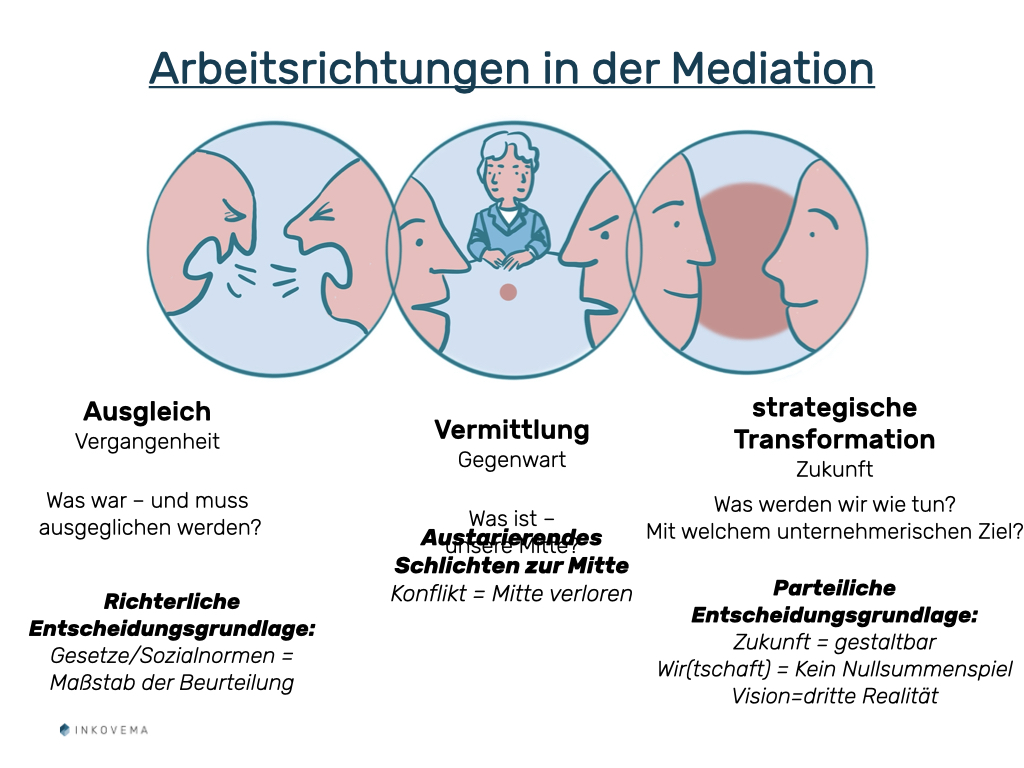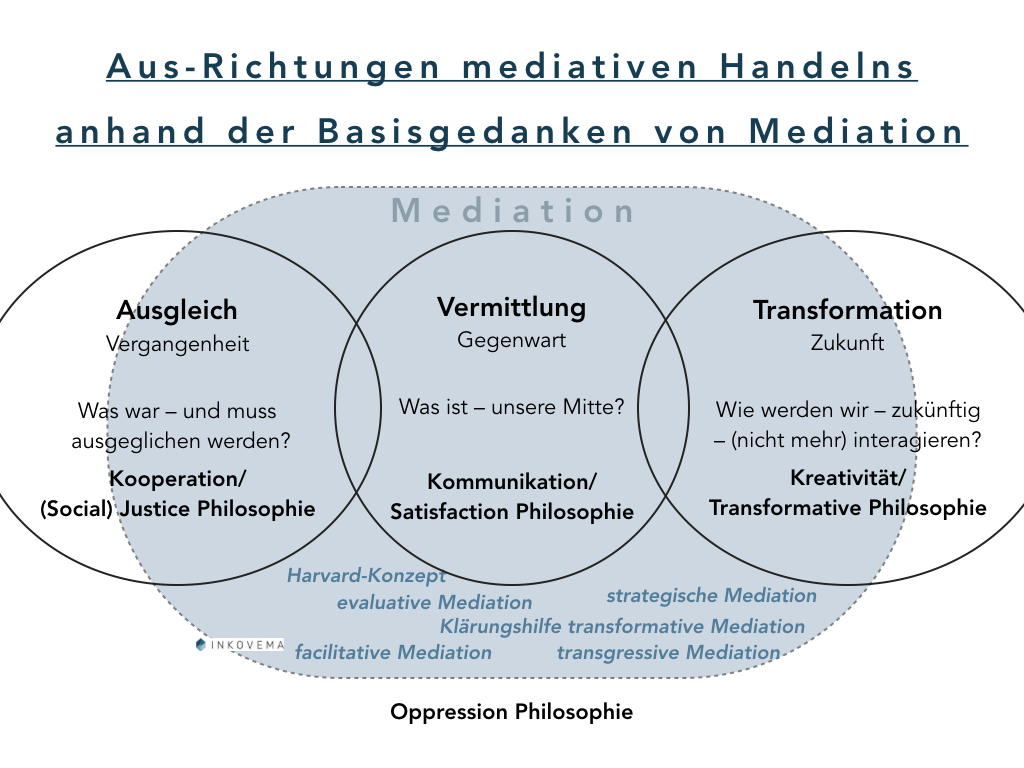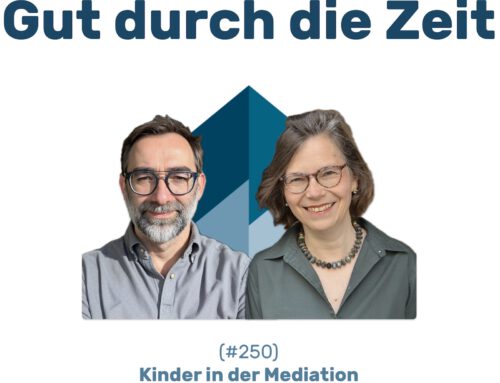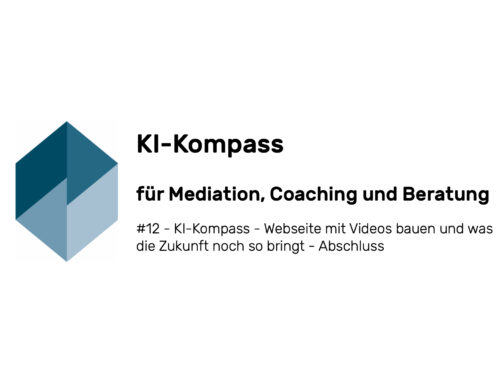Basic ideas of mediation as a map for localising mediation styles
Maps of mediation (3 of 3)
I. Introduction
The one Mediation does not exist.
There are a variety of ways to mediate in conflicts, to support the parties in their efforts to reach an agreement and to work out solutions.
All these attempts at mediation take place within mental Frame of reference within which Basic assumptions and basic patterns have an effect.
Certain basic assumptions lead to clusters of goals, methods and interventions that can be categorised as mediation styles.
In our small Series „Maps of Mediation“ is precisely about presenting such overviewing and classifying maps and models that present the order and structures of mediation methods and styles.
After we in the first part the map of L. Riskin (Riskin's Grid) and in the second contribution the Meta-model by Nadja AlexanderIn the third and final part of this series, the map of mediation will be presented, which uses the basic ideas of mediation and conflict resolution as a foundation on which to locate styles and methods of mediation.
Small series of articles on the maps of mediation styles
II Model of the directions of mediation
The basic ideas form the starting point of this model. Different styles can be localised and their similarities and differences identified on the basis of the temporal working directions. Within the temporal dimensions and their basic thematic orientation, premises can (ideally) be presented that can be weighted differently not only, but above all, in mediation. For – this much can already be said here – mediation is the form of conflict resolution in which the third party can control all temporal and thus also thematic dimensions and – utilise them in accordance with the mandate –. In this respect, the temporal and thematic dimensions can be used to analyse not only the „Classic“ judge-arbitrator-mediator differentiate, but also clarify individual styles of mediation. That’s what this is all about.
1. basic ideas of conflict management
Every conflict management three basic ideas which (can) be operated differently: Equalisation, mediation and transformation.
Equalisation means that the third party ensures that perceived injusticecaused by past actionsThe idea of reconciliation is to balance out the past between the parties to the conflict, be it through acts of reparation (e.g. monetary payments, restitution) or through communicative acts such as requests for apologies and their acceptance, the recognition of the perception of injustice or simply through the mediator's support in clarifying what has happened and why. The idea of reconciliation brings the conflict parties' past into the conflict management process, recognises the injuries suffered and calls for reconciliation. It is the idea of reconciliation that allows third parties to ensure that appropriate, above all communicative conditions for understanding interaction are created. Ultimately, however, it is a question of the specific conflict resolution procedure as to whether the idea of reconciliation is based on understanding or on having to tolerate. A judge is not dependent on the parties understanding each other's injustice in order for his decisions to be legal, effective and enforceable. The situation is different in mediation.
In the long term, for example, it is not worth rushing to "plant" agreements on sometimes old, deep-seated injuries and perceived injustices. In mediation, equalising, justice-creating measures are sometimes required on the way to conflict resolution - even if only through the communicative acts mentioned above. Successful equalisation efforts make it possible to focus on the potential of the present. This is where co-operation becomes a necessity.
Mediation means that the third party "balances" the parties to the conflict in their current conflict and explores the communicative centre. The idea of mediation is a reminder that the parties have their Conflict situation now the subject of their communication "must" do. Only then, according to the thesis (and not perhaps at some point), can the open paths to the future be recognised. Linguistically, one might think that because mediation means mediation, this is where the core content of mediation should be located. However, this is misleading: mediation in an unbiased understanding is the The core business of arbitration.
It is no wonder that mediation and conciliation are often confused or used interchangeably, because although mediation is part of the language of mediation, it is in fact the simple business of conciliation.
It therefore becomes clear at this point why it is "still" mediation when the third party acts in an evaluative manner or intervenes with concrete, but by no means rash, suggestions. In fact, these are conciliatory activities, but the separation of conciliation and mediation is by no means uncontroversial. For the sake of theoretical clarity, this paper follows this approach, knowing full well that the practice of conflict management requires evaluative, suggestive interventions – or simply conciliation elements that by no means exclude or even destroy mediation itself.
Digression: This is also where the legislative ideas on the Dispute mediator within the meaning of the Consumer Dispute Resolution Act of 1 April 2016, which in principle regulates arbitration for consumer dispute resolution – and also permits (modified) mediation (Section 18 VSBG). This mediation or the possible mediative competences are in the service of a "simple" solution to the mass problem of "consumer conflict", which threatens to escalate in court.
Transformation means that mediative conflict management is also about the development and learning potential of the personalities involved. By strengthening self-esteem (empowerment changes) and recognising each other's interests and needs (recognition changes), conflict communication can be changed and transformed into constructive cooperation (Bush/Folger, 2009; Hösl, 2016; Hösl, 2011, p. 137; Lang-Sasse, 2013, p. 55; Windsch, 2015, p. 55 f.). Under this banner, mediation becomes a place of learning and a phase of maturing.
Direction of the The idea of transformation is not so much the concrete settlement of the conflict through a material solution, but rather the Designing a social learning process by constructively changing the way both sides communicate about the conflict. It then becomes easier to resolve and settle the conflict. The idea of transformation opens up the possibility, the unknown of the future - while the idea of equalisation and mediation focuses on the past and present: What will we do differently in the future? This is the key question of change and therefore transformation management.
What will we have learnt (from each other)? What do you want to achieve here? What is it about for you? What will change for me personally and for us together as a result of our shared experiences during the mediation? These questions are aimed less at reflecting on what has happened and more at Creation of the futureorientated towards current interests and needs. In a nutshell, the transformative approach could also be called visionary if the ideologically charged aspect of the "new man" did not immediately resonate. Transformative realises the aspect of substantial design and challenges the forces of relational creation.

2. third parties handling the conflict and their temporal and thematic working direction
The basic ideas of mediation are an excellent point of reference for the mediator intervening in practice to orientate the content of his work. It forms hypotheses and assumptions, how the possibly equalising, always mediating and at best transforming communication process is structured can be realised. What do those involved in the conflict need and how can they be supported? The basic ideas help to Appropriate guiding questions for this work to create and intervene.
☞ Tips: Exemplary guiding questions for hypothesis and intervention formation
- What do the mediators need to talk about in order to find clarification?
- What is needed for the process so that the mediators can work out a viable solution?
- Is there a need for an apology for a past Behaviour or other compensatory measures?
- How do the mediators manage to reach an understanding about their Ideas for the future and ideas and recognise similarities?
- What is now for the moment important, what do you need current?
The basic ideas encourage you to focus on different time dimensions as well as the associated topics. Depending on which basic idea is particularly emphasised, specific (mediation) styles can also be recognised from the observer's perspective.
The Concept of equalisation lets into the Past of those involved take a look. What happened? Who did or failed to do what? This is where issues of justice and compensation come into focus. Even emotional wounds are ultimately framed in concrete, objective terms. The main themes here are past actionsboth actions and omissions.
The Mediation idea takes the Present into view: What do we need right now to have a good dialogue with each other? Have we talked about all the pressing issues? What else is needed? (The answer can then in turn lead "into the past"..., whereby it must remain clear that memory always reflects the present, never the past! Actions.
The The idea of transformation takes the Future (working) relationship and is heading for the future. What do you actually want to do in the future when this is over? This is often about Ideas, wishes, hopes, visions of the future. Jens Beckert names them as „imagined futures“.






Leave A Comment